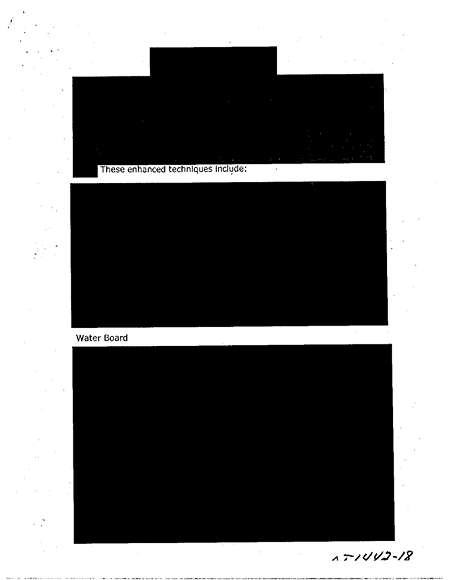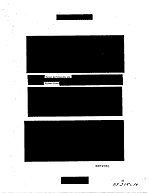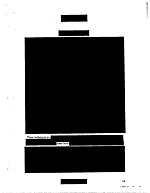Found 4306 matches from 1,400 records in about 0.0982 seconds for phone or e or geodeta.
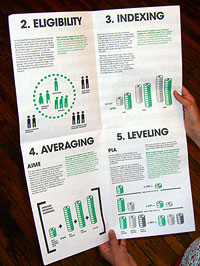 The Center for Urban Pedagogy sends along this open call for designers for its series of borchure-and-poster visual briefs on vital issues in US policy. Their text:
The Center for Urban Pedagogy sends along this open call for designers for its series of borchure-and-poster visual briefs on vital issues in US policy. Their text:
“Making Policy Public, CUP’s new collaborative series of publications, uses innovative graphic design to explore and explain public policy. Our distinguished jury has selected advocates’ proposals for the next issues of Making Policy Public. We are now seeking designers to collaborate with these advocates to illuminate the issues. Designers chosen through the juried submission process will receive full attribution for their work, an honorarium of $1000, and publicity through CUP.”
See the four policy briefs for 2008, as well as previous briefs on The Cargo Chain and The Social Security Risk Machine.
Expressions of interest and a limited portfolio are due Monday, June 16.
For submission guidelines and more about the project, visit the Making Policy Public website: http://www.makingpolicypublic.net
The ACLU has posted a handful of documents they’ve pried from the CIA about the use of waterboarding on prisoners in CIA custody.
After the Director of the CIA publicly admitted that the CIA has, in fact, used waterboarding, the agency could hardly argue that this was a state secret.
The documents are, of course, heavily redacted, an insolent gesture of spite to the court, the ACLU and concerned citizens. The graphic effect is comically absurd — and chilling to imagine what else lies beneath the black. Click below for a larger image.

The May 2003 image of President Bush on the deck of the aircraft carrier in front of the “Mission Accomplished” banner is, I think, one of the more memorable images from the war in Iraq. Primarily, of course, because no weapons of mass destruction were ever found (our mission, right?), the war rages on and US and Iraqi lives continue to be lost. Every day.
But there’s another story behind the image and Bush’s statement about the end of “major combat operations in Iraq.”
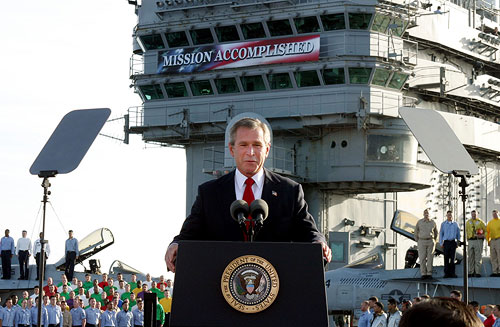
Below, a quote from Philip Gourevitch in conversation with Errol Morris at the 2007 New Yorker festival:
“One of the legal fictions of this period, you may think that the May 1st declaration by the President on the aircraft carrier that major combat operations had ended was merely a campaign period photo op. But in fact, it’s a redefinition of the theater of war.
During a war, you’re fighting against an enemy power and if you capture their people they’re enemy POWs and there are all kinds of rules that apply, but they’re never going to be charged with a crime. They’re simply treated as enemy combatants, enemy assets that you’re neutralizing, you remove them to the rear and as soon as combat’s over you release them. And believe it or not, May 1 of 2003 a lot of them were released. And a lot of them were kept as ‘security detainees,’ this fictitious word for prisoners. It’s a euphemism.
And the reason they were able to keep them in Abu Ghraib was because, of course, you can’t have a combat zone in a non-combat zone. And you can’t have enemy prisoners of war to whom you apply prisoner of war doctrine in a place where there is no enemy power and where there is no alternate army. So you can’t say to whom they belong and so they must be ‘insurgents.’ Insurgents against what? There isn’t an Iraqi government. So it’s a very complicated legal status, and its these loopholes that are being exploited for simply rounding people up and tossing them in there.”
And Abu Ghraib is, of course, where some of those other memorable photos were taken.
After much searching I finally found an electronic version of this essay via a dead link and archive.org. I’m posting here to save it from the memory hole — and have fixed the HTML formatting in the process.
By Langdon Winner, from The Whale and the Reactor: A Search for Limits in an Age of High Technology. Chicago: University of Chicago Press, 1986. 19-39. This essay first appeared in Daedalus 109 (1980): 121-36.
No idea is more provocative in controversies about technology and society than the notion that technical things have political qualities. At issue is the claim that the machines, structures, and systems of modern material culture can be accurately judged not only for their contributions to efficiency and productivity and their positive and negative environmental side effects, but also for the ways in which they can embody specific forms of power and authority. Since ideas of this kind are a persistent and troubling presence in discussions about the meaning of technology, they deserve explicit attention.
Writing in the early 1960s, Lewis Mumford gave classic statement to one version of the theme, arguing that "from late neolithic times in the Near East, right down to our own day, two technologies have recurrently existed side by side: one authoritarian, the other democratic, the first system-centered, immensely powerful, but inherently unstable, the other man-centered, relatively weak, but resourceful and durable."1 This thesis stands at the heart of Mumford’s studies of the city, architecture, and history of technics, and mirrors concerns voiced earlier in the works of Peter Kropotkin, William Morris, and other nineteenth-century critics of industrialism. During the 1970s, antinuclear and pro-solar energy movements in Europe and the United States adopted a similar notion as the centerpiece of their arguments. According to environmentalist Denis Hayes, "The increased deployment of nuclear power facilities must lead society toward authoritarianism. Indeed, safe reliance upon nuclear power as the principal source of energy may be possible only in a totalitarian state." Echoing the views of many proponents of appropriate technology and the soft energy path, Hayes contends that "dispersed solar sources are more compatible than centralized technologies with social equity, freedom and cultural pluralism."2
 Yesterday the New York State Assembly passed legislation to update the State’s “Bottle Bill”... with the “Bigger Better Bottle Bill.”
Yesterday the New York State Assembly passed legislation to update the State’s “Bottle Bill”... with the “Bigger Better Bottle Bill.”
The bill (A-8044-A/Sweeney) expands the five-cent bottle deposit and refund to include non-carbonated beverages such as bottled water, iced teas and sports drinks. Unredeemed deposits will help fund New York’s Environmental Protection Fund. The old bottle bill did not require deposits on non-carbonated beverage containers, nor did it mandate that revenues from unclaimed deposits be paid to the State. Bottled water, teas, juices and sports drinks didn’t much exist when the initial law was passed in 1982, but have since grown to 25% of the market.
From the bill’s accompanying memo:
“New York’s ‘bottle bill’ is one of the State’s most successful recycling and anti-litter initiatives. There is less litter and broken glass in our streets, farm fields, playgrounds, parks and beaches as a result of the bottle bill. It has also reduced the burden of solid waste disposal that is shouldered by local governments and taxpayers.
Since the enactment of the original bottle bill in 1982, non-carbonated beverages such as bottled water, juices, teas and sports drinks have become extremely popular. Millions of bottles and cans from such beverages end up in the trash or littering the environment because consumers lack an incentive to recycle such containers.
Updating the bottle bill to include non-carbonated beverages will provide an incentive to make our environment cleaner and safer by increasing recycling. By requiring beverage companies to provide unclaimed deposits to the State for deposit into the EPF, the bill will also generate new funding for State and local environmental programs. It is estimated that expansion of the bottle bill will result in at least $100 million for deposit into the EPF.”
Watch a two minute video overview on YouTube from the Surfrider Foundation.
The bill was passed unanimously in the Assembly, but faces opposition in the State Senate. The law is opposed by big beverage corporations, grocers and liquor store owners who anticipate higher operating costs. On the other hand, the bill has an impressive list of supporters. NYPIRG has a campaign page up at http://www.nypirg.org/enviro/bottlebill.
Bottlebill.org tracks container deposit laws around the world that require a minimum refundable deposits on beverage containers.
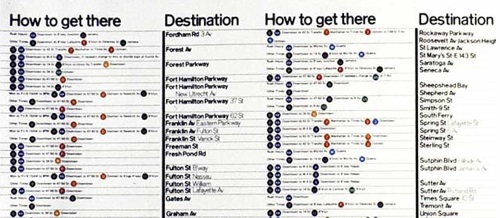
One frequent request from users of my little Flash map is a way to map traffic to their website. So here it is. The map above displays a week of traffic to the map home page.
I adapted the geocounter PHP script to query the hostip.info API and convert IP address to latitude and longitude and store the location in a database.
There are a few tools that map traffic by adding dots to a PNG or markers to an embedded Google map, but I find these cluttered and cumbersome. My map does a few things differently:
- With a single click, zoom into a cluster of points to see a finer, more detailed view. No more bouncing to Google or fiddling with a lot of navigation buttons. You can also click-and-drag to zoom into a specific selection, or click on the edge of the frame to move around.
- Additional traffic increases the total area of the dots proportional to the number of hits you get, not just doubling diameter with each subsequent hit.
- Points fade over time as the traffic record ages.
- Traffic from the same location over multiple days is represented by concentric circles, older visits shown in outer rings that fade over time.
- You can customize colors of the points, background, countries and borders. For instance, see darker, analog-style version on the map home page.
- You can configure the how long you want to store traffic data, and the minimum size of the points.
The geocounter script is GPL’ed and the map is free for personal or non-profit use, but requires a license for commercial use. For more information visit http://backspace.com/mapapp/.
Download the PHP scripts and world map at http://backspace.com/mapapp/geocounter.zip.
It's been thrilling watching traffic show up from far-flung places. Sort of takes me back to the old web odometer days. Enjoy!
From Jan van Toorn, Introduction, Design beyond design: critical reflection and the practice of visual communication:
“Design has become the instrument par excellence for the achievement of social cohesion through form — form as surface, a casing in which an apparent social consensus is created that hides the reality of the cultural condition in a reassuring and entertaining manner.…
In the case of visual journalism and communication design, this means adaptation to the social relations of power, collaborating with and promoting the depoliticization of the media through the primacy of aesthetics as beauty, of visual and other rhetoric that erodes the promise of democracy and participation. The main consequence of all this is that we live in a world in which, to quote Rem Koolhaas, ‘the reality of the socio-economic condition is camoflaged by the decorative glorification of the inevitable.’”
page 1 2 3 4 5 6 7 8 9 10 11 12 13 14 15 16 17 18 19 20 21 22 23 24 25 26 27 28 29 30 31 32 33 34 35 36 37 38 39 40 41 42 43 44 45 46 47 48 49 50 51 52 53 54 55 56 57 58 59 60 61 62 63 64 65 66 67 68 69 70 71 72 73 74 75 76 77 78 79 80 81 82 83 84 85 86 87 88 89 90 91 92 93 94 95 96 97 98 99 100 101 102 103 104 105 106 107 108 109 110 111 112 113 114 115 116 117 118 119 120 121 122 123 124 125 126 127 128 129 130 131 132 133 134 135 136 137 138 139 140 141 142 143 144 145 146 147 148 149 150 151 152 153 154 155 156 157 158 159 160 161 162 163 164 165 166 167 168 169 170 171 172 173 174 175 176 177 178 179 180 181 182 183 184 185 186 187 188 189 190 191 192 193 194 195 196 197 198 199 200 201 202 203 204 205 206 207 208 209 210 211 212 213 214 215 216 217 218 219 220 221 222 223 224 225 226 227 228 229 230 231 232 233 234 235 236 237 238 239 240 241 242 243 244 245 246 247 248 249 250 251 252 253 254 255 256 257 258 259 260 261 262 263 264 265 266 267 268 269 270 271 272 273 274 275 276 277 278 279 280 281 282 283 284 285 286 287 288 289 290 291 292 293 294 295 296 297 298 299 300 301 302 303 304 305 306 307 308 309 310 311 312 313 314 315 316 317 318 319 320 321 322 323 324 325 326 327 328 329 330 331 332 333 334 335 336 337 338 339 340 341 342 343 344 345 346 347 348 349 350 351 352 353 354 355 356 357 358 359 360 361 362 363 364 365 366 367 368 369 370 371 372 373 374 375 376 377 378 379 380 381 382 383 384 385 386 387 388 389 390 391 392 393 394 395 396 397 398 399 400 401 402 403 404 405 406 407 408 409 410 411 412 413 414 415 416 417 418 419 420 421 422 423 424 425 426 427 428 429 430 431
[ Back ]
[ Next ]


